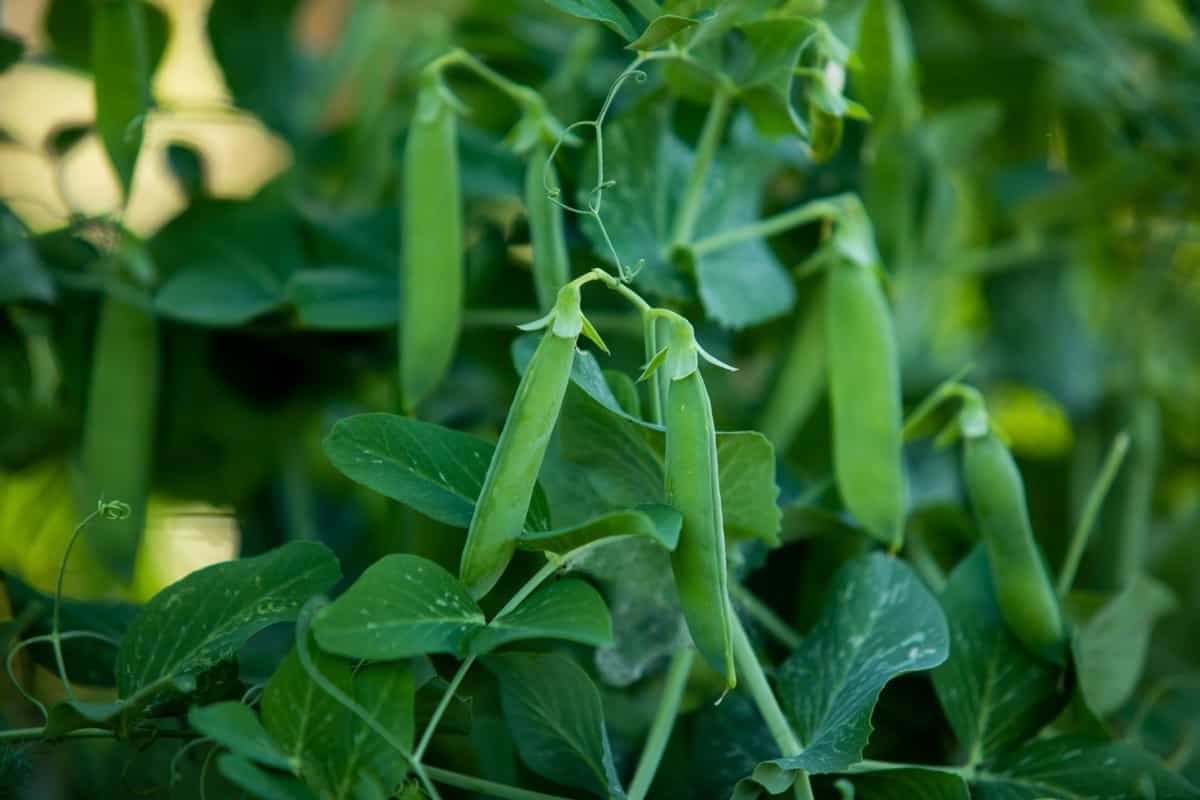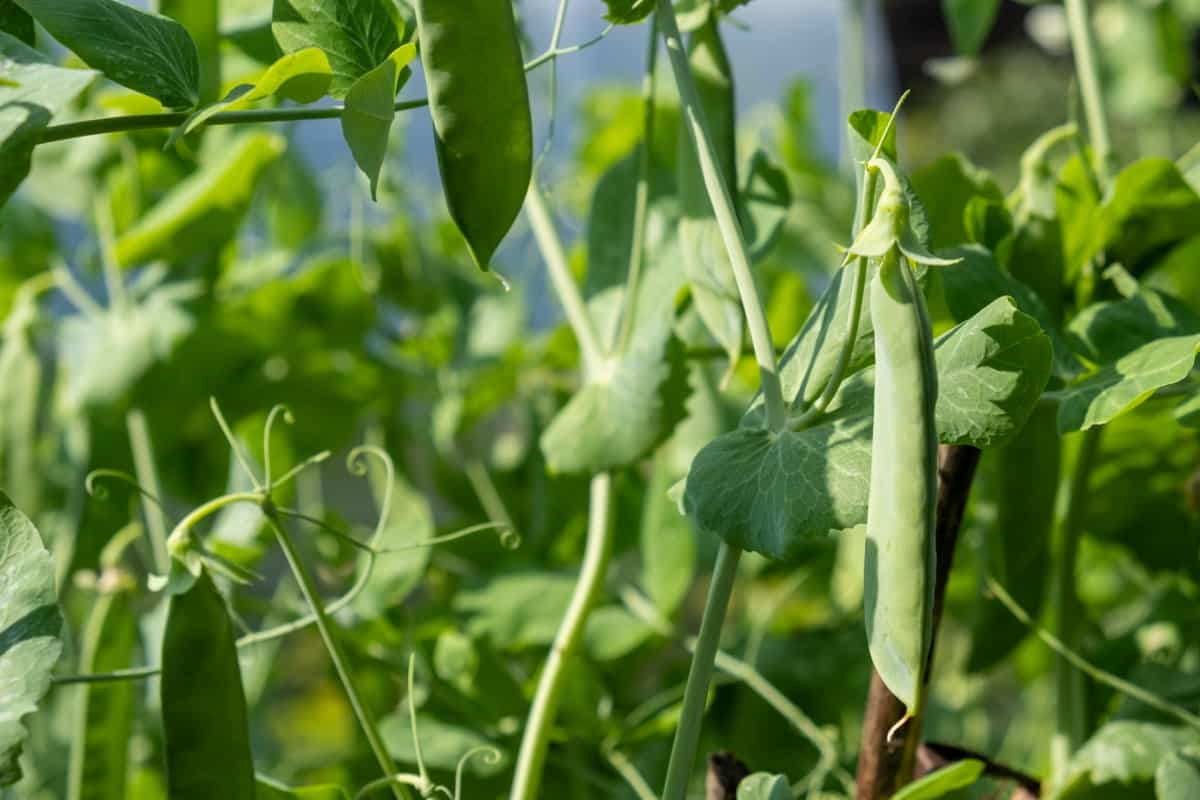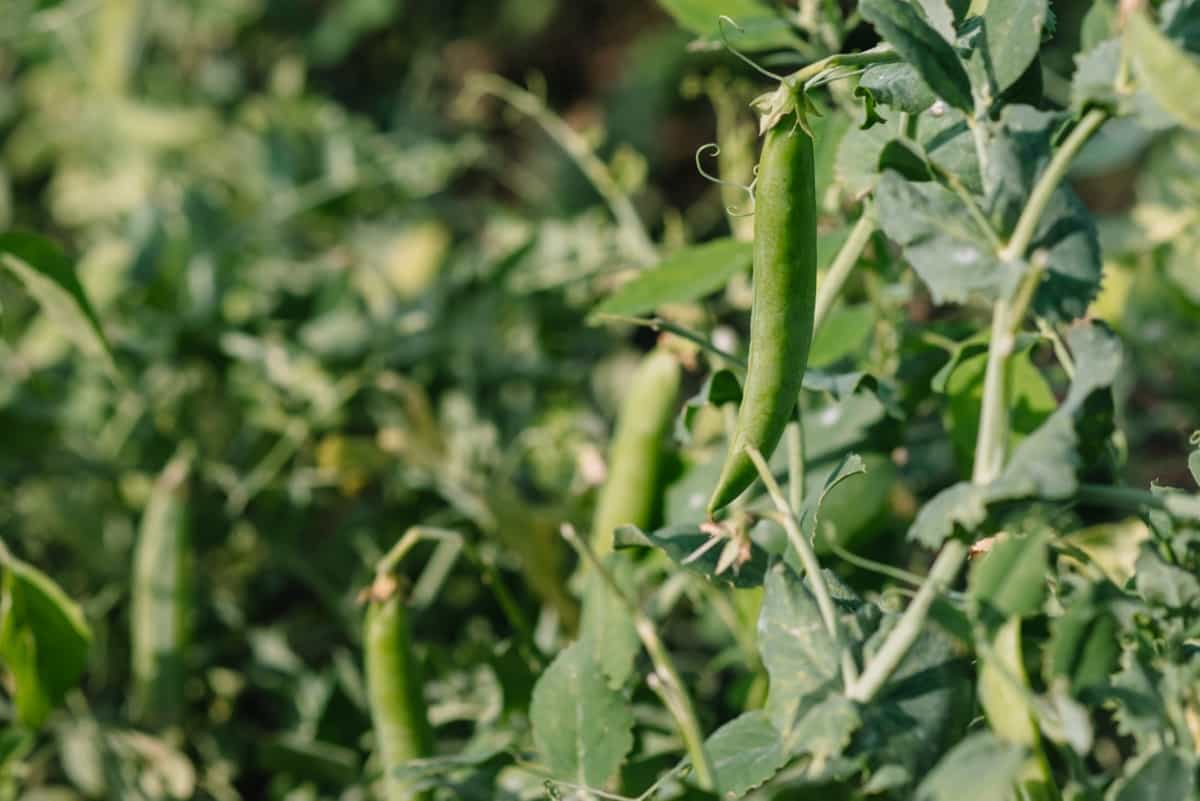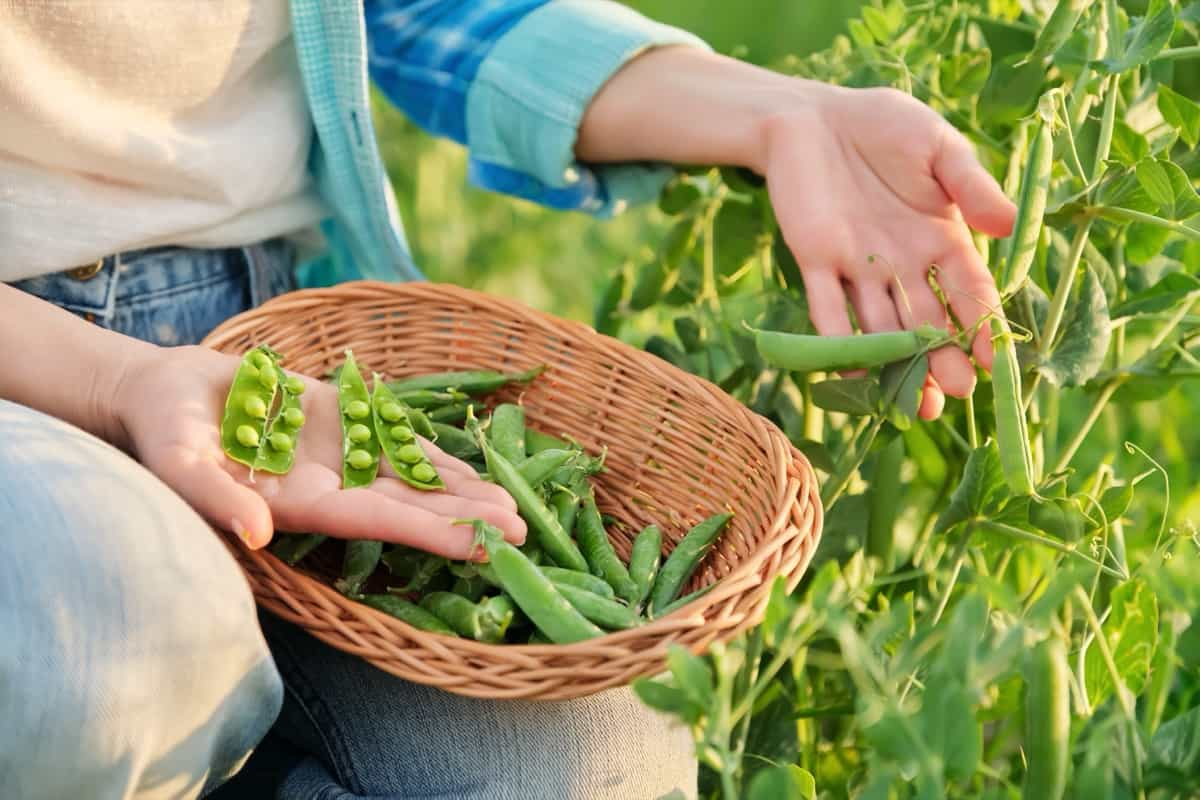DIY organic fertilizers for pea plants can be made from a variety of natural materials readily available in most homes or gardens. These fertilizers not only deliver essential nutrients like nitrogen, phosphorus, and potassium but also improve soil health and structure, encouraging a thriving pea crop. Some of the popular organic fertilizer recipes are:
- Compost Tea: Compost tea is made from steeping compost in water. To make it, simply fill a bucket with water and add well-aged compost. Let the mixture sit for a few days while stirring occasionally. Once the water turns dark brown and has a rich, earthy smell, strain out the solids and dilute the liquid before applying it to your Peas.
- Manure Tea: Another option is manure tea, which is created by soaking aged animal manure in water. This process allows beneficial microbes present in the manure to multiply and release nutrients into the solution. Dilute this concentrated mixture before using it on your Pea plants.
- Seaweed Extract: Seaweed extract is an excellent choice for providing essential minerals to your Peas. Soak the dried seaweed in water until it rehydrates completely, and then strain out any solid pieces. You can spray the resulting liquid onto your Pea plants or use root drenches.

Homemade Fertilizers for Peas
DIY Nutrient-Rich Compost
Ingredients
Creating your nutrient-rich compost is not only cost-effective but also a sustainable way to nourish your Pea plants. You can produce an organic fertilizer by recycling kitchen scraps and yard waste, that will promote healthy growth and abundant yields. To start with, gather a mix of brown materials, like dried leaves or straw, and green materials, like grass clippings or vegetable peels. These ingredients provide the necessary carbon-to-nitrogen ratio for successful composting.
Composting Process
Layer your brown and green materials in a bin or pile, ensuring proper air circulation by occasionally turning it over. Add some water to keep the mixture moist but not soggy. Over time, beneficial microorganisms will break down the organic matter into rich humus-like compost.
Compost Application
Once your compost has reached a crumbly texture with an earthy smell, it’s ready for application. Spread compost around the base of each Pea plant while avoiding direct contact with stems to prevent rotting.
Vermicompost Fertilizer
Vermicomposting Basics
Vermicompost fertilizer is a fantastic organic Pea fertilizer option for nourishing your Peas. The vermicomposting process involves using worms to break down organic waste materials, like kitchen scraps and garden debris, into nutrient-rich compost. It’s an excellent way to recycle household waste while creating a valuable soil amendment.
Making Vermicompost Tea
To make vermicompost tea, you’ll need some finished vermicompost (the dark, crumbly material that the worms leave behind) and water. Simply mix a small amount of vermicompost with water in a container and let it steep for 24-48 hours. The resulting liquid can be diluted further before application.
Applying Vermicompost to Peas
When applying vermicompost tea to your Pea plants, pour it directly onto the soil around the base of the plant or use it as a foliar spray on the leaves. This will help deliver essential nutrients like nitrogen, phosphorus, potassium, and beneficial microbes straight to their roots.
In case you missed it: How to Make Coco Peat at Home: A Step-by-step Preparation Guide

Coffee Grounds Fertilizer
Coffee Grounds Composition
Coffee grounds can boost energy in the morning. They can also be a great source of nutrients for our plants, including Peas. Coffee grounds contain high organic matter and contain essential nutrients like nitrogen, phosphorus, and potassium. They also have trace amounts of calcium, magnesium, and sulfur. Plus, they add beneficial microorganisms to the soil.
Preparation of Coffee Grounds Fertilizer
To prepare coffee ground fertilizer for your Peas, collect used coffee grounds. Spread them on a tray to dry completely. Once dry, you can simply sprinkle the coffee grounds around the base of your Pea plants or mix them into the soil.
Applying Coffee Grounds to Peas
When applying coffee grounds to Peas (or any other plant), it’s important not to overdo it. Aim for about half an inch of coffee ground layer around each plant, or mix one-part dried coffee grounds with three parts potting soil when transplanting seedlings.
Epsom Salt Fertilizer
Benefits of Epsom Salt for Peas
Epsom salt can work wonders for your Pea plants. This natural and affordable fertilizer offers several benefits that can promote healthy growth and abundant harvests. One of the key advantages of using Epsom salt is its ability to boost nutrient absorption in Peas. The magnesium in Epsom salt plays a crucial role in photosynthesis, aiding the production of chlorophyll. By ensuring an ample supply of magnesium, you’ll help your Pea plants efficiently convert sunlight into energy.
Mixing Epsom Salt Solution
To make an Epsom salt solution, dissolve a tablespoon of Epsom salt in one gallon of water. Stir well until the crystals are fully dissolved. It’s important not to exceed this concentration, as excess magnesium can have adverse effects on plant health.
Application Frequency and Method
When applying Epsom salt to Peas, moderation is key. Start by spraying the foliage with the diluted solution once every two weeks during active growing periods. However, be cautious not to spray directly on blossoms or young pods, as this may cause damage. Alternatively, you can apply Epsom salt directly into the soil around your Pea plants at planting time or during early stages when they require extra nutrients for vigorous root development.
Banana Peel Fertilizer
Nutrients in Banana Peels
Banana Peel Fertilizer is an excellent way to provide essential nutrients to your Peas while reducing waste. Banana peels contain a high quantity of potassium, phosphorus, and calcium, which are important for plant growth and development.
In case you missed it: How to Grow Peas from Seed to Harvest: Check How this Guide Helps Beginners

Banana Peel Fertilizer Preparation
To prepare banana peel fertilizer, start by cutting up the peels into small pieces. Then, place them in a jar filled with water and let it sit for about a week. This process allows the nutrients from the peels to seep into the water, creating a nutrient-rich solution. Once the mixture has fermented for a week, strain out any remaining solids and dilute the liquid with water at a 1:2 ratio (one part fertilizer to two parts water). This ensures that you don’t overfeed your plants.
Applying Banana Peel Solution to Peas
When applying banana peel solution to your Peas, pour it directly at the base of each plant or use a spray bottle to mist their leaves. The nutrients will be absorbed through their roots or foliage. By using the Best homemade Pea feed banana peel fertilizer on your Peas and Organic Pea care tips, you not only provide them with essential nutrients but also reduce kitchen waste in an eco-friendly manner.
Eggshell Fertilizer
Calcium Benefits for Peas
Eggshells are packed with calcium carbonate, which helps strengthen cell walls and promotes overall plant health. Plus, they’re readily available and cost-effective, and it is one of the best Homemade organic fertilizers for Peas.
Eggshell Fertilizer Preparation
To prepare Eco-friendly Pea fertilizer options like eggshell fertilizer, start by collecting clean eggshells from your kitchen. Rinse them to remove any residue and let them dry completely. Once dried, grind the eggshells into a fine powder using a blender. This powder can be directly sprinkled onto the soil around your Pea plants or mixed into compost for an added boost of nutrients.
Incorporating Eggshells into Soil
Incorporating eggshells into the soil not only provides calcium but also improves drainage and texture. When it comes to DIY Pea soil amendments, Crushed eggshells act as natural mulch, preventing weeds from sprouting while retaining moisture in the soil. By utilizing this DIY Pea plant food, you’ll be giving your Peas the extra dose of calcium they need to grow strong and healthy.
Fish Emulsion Fertilizer
Nutrient Content in Fish Emulsion
Fish emulsion fertilizer is a fantastic organic option for providing essential nutrients to your Pea plants. This Natural Pea fertilizer solution is rich in nitrogen, phosphorus, and potassium – three key elements that are crucial for healthy plant growth. The nutrient content in fish emulsion helps promote strong root development and vigorous foliage.
Homemade Fish Emulsion Recipe
To make homemade fish emulsion fertilizer, you’ll need fish scraps or whole fish, water, and a large container. Cut the fish into small pieces and place them in the container. Add water until the fish is fully submerged. Let it sit for several weeks to allow fermentation to occur.
Dilution and Application Techniques
Once fermented, strain the liquid from the solid remains of the fish using a fine mesh sieve or cheesecloth. Dilute the concentrated liquid with water at a ratio of 1:4 (one part fish emulsion to four parts water). This dilution ensures that your plants receive enough nutrients without risking burning their roots.
When applying fish emulsion fertilizer to your Peas, use a watering can to distribute it around the base of each plant evenly. Avoid getting any on leaves as this may cause damage or burn them under direct sunlight.
Regular application every two weeks during active growing periods will help keep your Pea plants well-nourished throughout their lifecycle. Remember to follow label instructions if using store-bought versions of this Homemade organic Pea fertilizer.
Molasses Fertilizer
Role of Molasses in Soil Health
When it comes to soil health, molasses plays a vital role in improving its overall condition. It acts as a natural source of energy for beneficial microorganisms in the soil, promoting their growth and activity. These microorganisms help break down organic matter and release essential nutrients that are crucial for plant growth.
In case you missed it: Best Fertilizer for Black Pepper Plants: Nutrient Management in Black Pepper/Piper Nigrum Farms

Making Molasses Fertilizer Solution
To make a molasses fertilizer solution, simply mix one tablespoon of unsulfured molasses with one gallon of water. Stir the mixture thoroughly until the molasses are completely dissolved. You can use it as a foliar spray or applied directly to the soil around your Peas.
Using Molasses Fertilizer for Peas
Using molasses fertilizer for Peas has several benefits. It helps improve nutrient uptake by enhancing microbial activity in the soil. As a result, your Pea plants will have access to more nutrients like nitrogen and phosphorus, which are necessary for healthy growth and abundant yields. Additionally, molasses can also boost plant immunity by stimulating the production of beneficial bacteria and fungi that protect against harmful pathogens and pests.
Grass Clipping Fertilizer
Grass Clipping Composition
Grass Clipping Fertilizer is a fantastic way to utilize the grass clippings from your lawn and turn them into a nutrient-rich fertilizer for your Peas. Not only does it provide essential nutrients, but it also helps reduce waste by repurposing grass clippings that would otherwise end up in the trash.
The composition of grass clippings includes nitrogen, phosphorus, and potassium, which are all vital elements for healthy plant growth. By using these clippings as fertilizer, you can directly supply your Peas with the nutrients they need to thrive.
Grass Clipping Tea Preparation
To prepare Homemade Pea fertilizer mixtures like grass clipping tea, simply gather fresh grass clippings from your lawn and place them in a bucket or bin. Add water to cover the clippings and let them steep for several days.
Application of Grass Clipping Fertilizer to Peas
When applying grass clipping fertilizer to your Pea plants, dilute the tea with water at a 1:10 ratio (one part tea to ten parts water). Use this mixture to water your Pea plants every one to two weeks during their growing season. By utilizing Homemade plant food for legumes like Grass Clipping fertilizers, you not only save money but also contribute towards Sustainable Pea fertilization methods.
Conclusion
Homemade Pea fertilizer recipes can be an effective and sustainable way to nourish your Pea plants and promote healthy growth. From compost tea to banana peel fertilizer, there are various options to choose from when it comes to DIY organic fertilizers for Peas.
Using Homemade fertilizers for legumes not only benefits your Pea plants but also contributes towards a greener environment by reducing dependence on chemical-based products. Plus, it’s a cost-effective solution that allows you to make use of kitchen scraps and other natural resources.
- How to Grow Hibiscus from Flower
- Plantation Ideas for Home Decoration: A Beginners Guide
- Flower Garden Designs and Layouts for Beginners
- Planting and Spacing Techniques in Papaya: A Beginner’s Guide
- Growing Gold: Essential Techniques for Planting Pineapples
- How to Make Kalanchoe Plant Bushy: Home Remedies and Solutions
- 11 Reasons Why Your Gardenia is Not Blooming: Home Remedies and Solutions
- Eco Elegance: The Guide to Designing a Drought-Tolerant Landscape
- Gardening on a Slope: Strategies for Hillside Landscaping